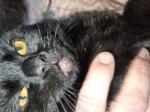Cat Scratch Fever Symptoms List
The classic cat scratch fever symptoms begin with a skin lesion at the site of a cat scratch, followed by painful swollen lymph nodes.
Also known as cat scratch disease (CSD), the symptoms are caused by an infection of Bartonella henselae.
B. henselae, the bacterium responsible for the disease, can also be contracted through a lick to an open wound, or possibly a bite.
If present, the skin lesion, appearing similar to an insect bite, may appear with three to ten days. The lesion may develop pus or fluid, or remain dry.
Within one to two weeks, the swollen lymph nodes will appear, sometimes with fever. Additional symptoms may include generalized aching, malaise, and loss of appetite.
Cat scratch fever symptoms are typically mild. According to several sources, depending upon which side of the fence you sit on, the disease is either fairly rare, or fairly common. This discrepancy can probably be explained by realizing that many cases may go undiagnosed.
In the U.S., about 2000 hospital admissions are reported out of the approximately 22,000 cases diagnosed each year. More than 20,000 cases might seem rare, until you compare that to only zero to two cases of the much feared rabies per year.
Affecting primarily people under age 21 (80 to 90 percent of cases), and more males than females, a cat scratch (or less commonly, a bite) is the typical start of the disease (hence the name, cat scratch fever).
About ten percent of cases have also been reported after exposure to non-feline animals, including squirrels, dogs, goats, and crabs. Barbed wire and porcupine quills have also been implicated.
Cat Scratch Fever Symptoms
The following symptoms are typically seen with cat scratch fever.
- Skin Lesions
- Swollen Lymph Nodes
- Fever
- Malaise
- Loss of Appetite, Weight Loss
- Headache
In recent years, cat scratch disease has been associated with more varied and serious illnesses. Atypical symptoms include those shown below.
The symptom list may be longer and more serious for the immunosuppressed, such as those with AIDS or undergoing chemotherapy treatments.
- Tonsillitis
- Osteomyelitis
- Central Nervous System disorders
- Seizures
- Combative behavior
- Extreme lethargy
- Coma
- Encephalitis
- Conjunctivitis
- Nerve disorders of the head, face and eyes
- Transient blindness
- Hepatitis and liver disorders
- Pneumonia or pulmonary disease
- Various skin symptoms and conditions
According to the Centers for Disease Control, "rare complications of B. henselae infection are bacillary angiomatosis and Parinaud's oculolandular syndrome."
Cat scratch fever is a self-limiting disease. As such, the symptoms should disappear on their own, usually within two to five months. The skin lesions, however, can last up to two years.
More About this Disease
Cat Scratch Disease - Information from the Centers for Disease Control.



Comments: What do you think?
Have your say about what you just read. Leave me a comment in the box below.